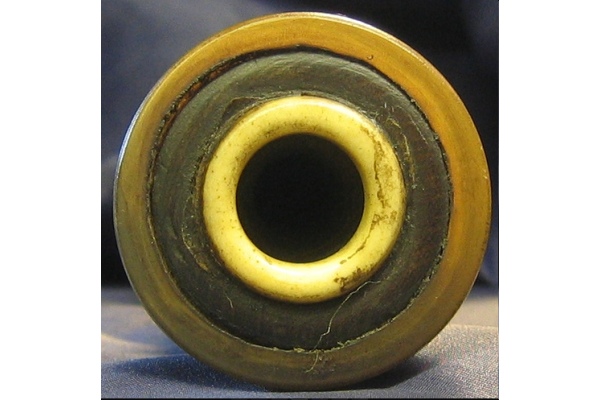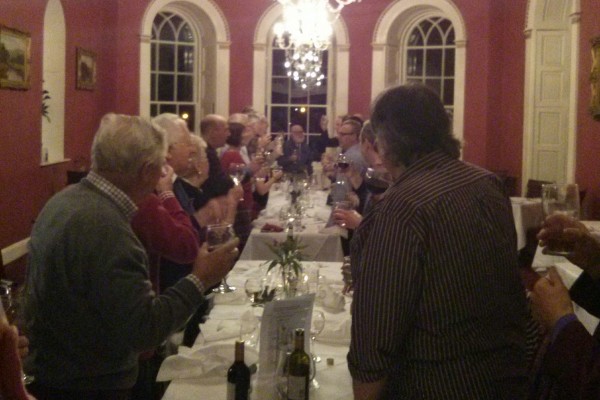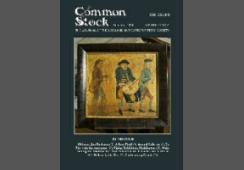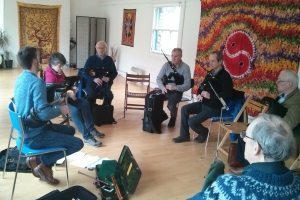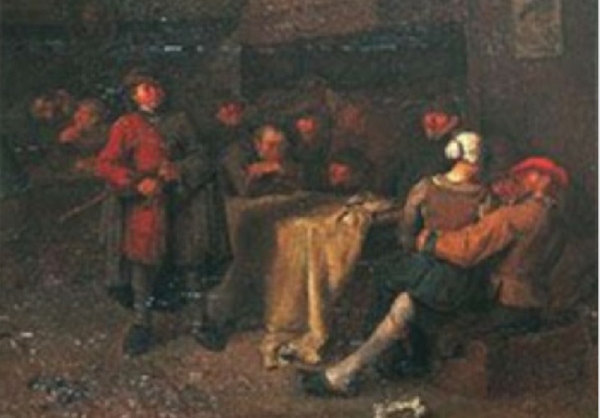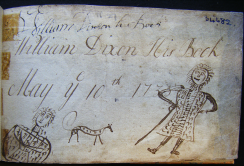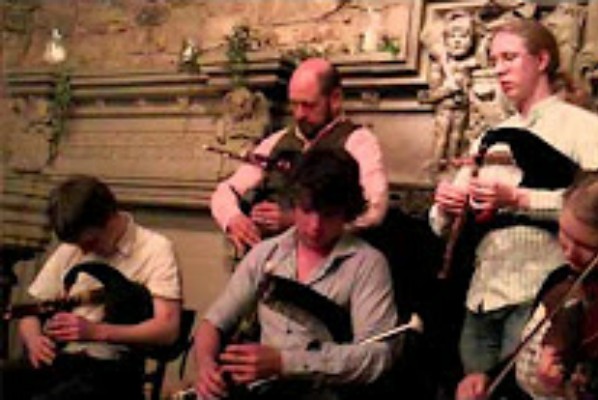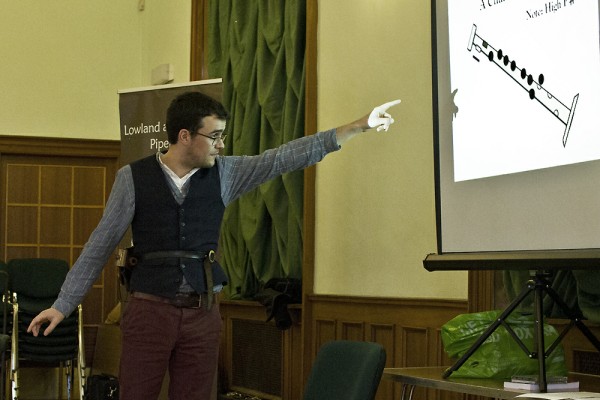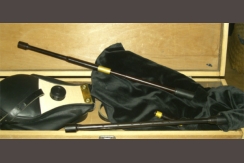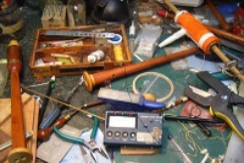The last speaker of the afternoon was Allan Macdonald, well-known for his seminal work on the links between Pibroch and Gaelic song.
It’s pleasure to be here. I sat for ages yesterday wondering, how am I going to deal with this today? I ended up making ten recordings of one song, and they were all slightly different from each other, and it reminded me of what my mentor did, Dr Peter Cooke here [ who was in the audience], who I met in the early days of the School of Scottish Studies, who’d written the first article that dealt seriously with an area which had never been properly addressed and that was the context of pibroch. Peter looked at a particular song and all the different versions, the pipe versions, of it, to see what we could learn from this. In retrospect I think what people learned was how much they had ignored – the whole context of the pibroch tradition.
It was on account of that article that I started asking questions – well I had asked many questions earlier, when I was about 17 or 18; I smelt something was wrong, something was far wrong with the pibroch tradition. I wasn’t sure what it was, it just didn’t seem right. So it was a number of years later before I got the opportunity to address it and to answer the questions for myself. I did an analysis of some pieces of music, some pibrochs, with certain songs that were known to have a relationship with the melody. And of course the songs, because they had travelled, a lot of them had changed in a long progression, whereas in the pibroch tradition things were frozen as if a camera shot had been taken of the earliest records, from 1760 and 1820 onwards and everything had become sacrosanct. I guess that’s the difference between classical music and traditional music – what they say in traditional music about classical musicians, we wait in great expectation of a tune breaking out. So basically what I was doing was looking for the tune. And the rhythm – I think it was the late Professor Tovi who said ‘music without rhythm is like a filleted fish’. I think that sums up modern pibroch performance to me, because I got very bored with it. I found myself going on to a platform, going through some motions, and putting up with some people arguing about the relevance of a grace note or something. It just didn’t make sense. And it clearly doesn’t make any sense now.
I don’t know how many of you know much about the background to pibroch, or have listened and given up or listened out of politeness. I think it’s summed up by a lady at one of the Blair Castle competitions, who was asked at half-time what she thought of the morning’s competition pibroch. ‘Wonderful,’ she said, ‘Absolutely wonderful; so good I fell asleep.’ And I thought, that kind of sums up a lot of what pibroch is – it’s this kind of landscape of sound, this ambience, this nice place to go – it’s sort of music therapy, care in the community.
So what I want to do is briefly say what the problems I perceived were. A bit like when they started notating pibroch, the first publication, around about 1819-20, it’s a bit like James Hogg’s mother said, when he started notating the border ballads, she said ‘what are you doing?’ He said ‘I’m writing out the songs I’ve been collecting’ and she said ‘that’s the end of the song then’. It’s a bit like that with pibroch. It’s been pushed onto a page, put behind bars.
I think one of the most influential pieces [Here Allan shuffled some papers]” I’m pretending I’ve got notes here. I’ve got lots of these [waving papers] It looks good when you have notes to look at.”
One of the most influential texts was that of Joseph MacDonald, who was a young man when he died in India, twenty-three years old. He partially notated tunes, giving an idea of the music that was being played at the time, very basic fragments. But it said so much – it told me a lot about how it was played. And then when you see what happened afterwards, how it was notated, it became very clear to me, once I took the words of melodies that were closely associated – once I put the words over the music, it was very clear then, to see what had happened. And one of the first ‘improvements’ – I guess that was the buzz, improving the peasant melodies, was to make them less – all these decorations which were called ‘introductions’ – Joseph MacDonald had these very interesting runs, down to the anacrusis to the theme note – And there may have been five notes, and there may have been even more notes that he never notated, basically the idea is that – for me it was clear- that this influence would appear to have come from the harp tradition. There’s an old Gaelic saying “the harp player of the old tune and the piper of the one tune”. I think some of these decorations – what happened was that they were – in the first publication of piping they were reduced to a three note decoration. I’ll give you an example in a tune that some say a variant of a Northumbrian piece Kathrene Ferrier sang called ‘Blow the Winds Southerly’ It’s been rooted in our history in Scotland since the 1600’s with different titles, a very popular melody.
So, Joseph MacDonald had these interesting runs into the melody, so it might sound like this;
[here Allan played examples]
This kind of downward runs of five or six notes were all reduced to three note introductions, and through time, through the 19th century, the pivotal note, E, became elongated. By the 1940’s, in this source the Kilberry Book – a very popular book because it’s easy to read the whole tune on one page – by this time this decoration had become part of the melody line and the music had slowed down considerably, and the rhythm of course, because of these elongated decorations in the form of single ‘E’ notes and the lack of clear identification of phrase- generally you’ll have 8 phrases, and in each phrase you’ll have 4 pulses, a bit like the chanson; some of them have 5 – some of the longer tunes have maybe 16 phrases, or 12 phrases, but generally there’ll be 8 phrases. The first thing I do is identify the phrase and play through the phrase just as you would be doing reading a piece of poetry or singing a song .
I’ll give you an example using this tune called Bodaich nam Briogais, ‘The Old Men with the Trousers’ or ‘The Women of the Glen’; this melody was used by Robert Burns on a couple of occasions – ‘Sweetest May’ and ‘Merry Hae I Been Teethin a Heckle’ – he used the same melody for both; Beethoven used it etc., etc. So what I’ll do is I’ll play the manner in which one would hear it today on the competition platform – the recognised, correct way. I’ll then sing, or croak, a fragment of the song and then I’ll play the re-interpretation of the tune in the light of the evidence of the rhythm of the song and I hope you’ll notice the difference, or I’m leaving now.
[here Allan played Bodaich nam Briogais]
I’ve been teaching this for seventeen years at the Piping Centre, as part of the music course, but unfortunately they were too scared to play this, because they felt that maybe they wouldn’t get enough points in their exams; so, the whole competition system is still running the course, so it hasn’t really moved along the same way as I thought it would, but I think things are changing; it takes time, because a lot of people consider that the changes are far too dramatic for them to be able to take on board. I ask the simple question ’If you played pibroch and it was handed down aurally - Canntaireachd is one way, but people just sang it, so you would hear the tune, you would hear the ground of the tune, so I would say to the students when they arrived the first week. I would say ‘well I expect you to have the ground, the theme off in, some five minutes, some fifteen minutes, maximum half an hour for most pieces you should be able to learn it in half an hour, and the looks I got were quite amazing, because they’re brought up to believe, as one writer, a competing piper, who wrote about pibroch, it takes two weeks up to a month to get the tune into your memory, up to two years before it becomes automatic I think is the word, and I thought God forbid, this poor music.
This music was handed on aurally, so it really had to have a melody. It had to have rhythm, it had to have something memorable, for it to be transmitted down over the centuries, and I’m beginning to agree more and more with Hogg’s mother.
By looking at tunes that have clear associations with words, and I did state that if you’re looking for the genuine version of a melody, then I’m talking about going back over a long period of time, of course melodies change, but once they’ve had words wrapped round them they’re less likely to change so much, I believe. And I think that the association of words keeps so many of these melodies in place, keeps the, from changing so much – certainly in the rhythmic way. So you’ll have a melody with three or four different texts associated with it but the melodic rhythm will generally remain the same and it’s so obvious, to me, that that conservatism would actually occur with so many of these tunes.
With the start of the competition system from the late seventeen hundreds on, where you had these wonderful writers writing about these events in Edinburgh where this wild piper would be marching around and the women wailing in the middle of the tune it all sounds a bit dramatic - the music obviously was far more animated than that which is played today
And so, as the late David Johnson who wrote about Edinburgh in the eighteenth century, he had a look at the pibroch tradition and commented ‘a lot of them were built on common or garden tunes’, and that variations were then added on to these tunes. That kind-of made sense when I noticed in one of the publications of Angus Mackay there was a pibroch there that had never been published by anyone but I think it was because it was too much of a common or garden tune; this was a tune called ‘We Will Tak the high Road’ which was a ruse de guerre in the 1600’s in the Montrose wars as the Stewarts of Appin were heading off to fight with Montrose and pretending that they weren’t, singing songs which suggested they were fighting with the government, because they were in Campbell country and so this tune – I don’t know how it got into London, but there they called it ‘London Bridge is Falling Down’
[Allan then played what your editor knows as the modern tune to Katie Bardie]
It doesn’t appear in the list of tunes in any of the piping competitions but it’s there, it’s a pibroch. Interesting that the tune Chris was paying earlier Wally as the Marquis Ran’ – they’re first cousins – they haven’t come up with a term to deal with these close variants yet, so first and second cousins is good enough. Another intriguing one was one called A' Ghleus Mheur or The Finger Lock; it’s interesting how what someone might comment on or write at one period of time lasts so long that people are still stating in the 1990’s that this pibroch called The Finger Lock which has a very esoteric title – and it has stories associated with Fairy lore, and maybe that made it even more esoteric - so that the story became that this was one of the most difficult pibrochs to play. A journalist in 1782, I think, in the Scots Magazine, said that The Finger Lock was one of the most difficult pibrochs and I heard someone saying that in 1990 – it’s a bit like Dr Johnson when he said that the best English in the country is spoken in Inverness and if you got o Inverness they’ll turn on you and say The best English is spoken in Inverness - so these things hold.
The late Colonel David Murray said to me once ‘I don’t understand why this tune the Finger Lock, it was on the list of the 74th Regiment as a reveille. How could such a boring, slow tune be used as a reveille? I said ‘Well its’ something to do with how it’s delivered’. I found a set of words in the Garrick Magazine dating back to 1870’s or 80’s. Strangely enough it was someone from my own village called MacDonald who was said to have written the words, but I think it was a sort of burlesque that soldiers had made on hearing a piper, probably sounding like a pet shop on fire, at six in the morning, waking them up. And of course what do you do but you retort in some way or other as a soldier. And so these words – very esoteric as well - go òl, òl, òl, òl, òl, òl, òl, òl, òl, òl, òl, òl, òl, òl, òl, òl, òl, òl, òl, òl, durich, òl, òl, òl. Which means ‘Drink, drink, drink, drink, drink, drink, drink, drink, drink, drink till you’re very drunk, and there was a whole set of verses about how they would drink their kilts, their garters, their bunnets and anything they had at all. Strangely, it’s kind of like a bugle. I was fortunately or unfortunately myself brought up with the bugle going off in the morning at Queen Victoria School. So it seemed quite appropriate that The Finger Lock should be used as a reveille. I’ll play it first of all the way one should play it, then I’ll give you a little of the song and then the re-interpretation based on the evidence of the song.
{Allan played and sang The Finger Lock]
So a much more animated piece. And it’s like a bugle, if my memory is right.
From a study of twelve pieces or so I was able to extrapolate and apply the same principles to the whole tradition. It was very exciting because, as I said, good tunes, they go through this very efficient aural tradition where, if it’s memorable it’ll carry on – if it’s not it’ll die and so a lot of these tunes are ones where when you get the melodies and the rhythms of them there are some beautiful pieces.
I did record one I might just play you a bit of, with a band in Germany and I put vocals over it. It’s The Park Pibroch. I changed it a little bit; I kept what they call the echo beats today – so what had been a one-stress figure became a two-stress figure so there was an extra beat put into the music – again having a great effect on the whole delivery.
[Allan played The Park Pibroch No 2 and finished with the comment]
There’s a lot of beautiful music in there, that hasn’t been played yet…

